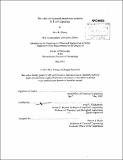The roles of clustered membrane proteins in T-cell signaling
Author(s)
Chung, Woo K. (Woo Keun)
DownloadFull printable version (16.23Mb)
Other Contributors
Massachusetts Institute of Technology. Dept. of Chemical Engineering.
Advisor
Arup K. Chakraborty.
Terms of use
Metadata
Show full item recordAbstract
Humans, like most other jawed vertebrates, are equipped with an adaptive immune system that can respond to diverse pathogens. Mature T cells, one of the most important immune cells generated from the thymus through a rigorous selection processes, are key orchestrators of the immune responses. Although many of the key signaling molecules in T cells have been discovered, the underlying mechanisms of how some of these signaling molecules interact with each other in space and time to trigger T cell activation have not yet been established. Furthermore, recent experimental results demonstrate that the membrane is a highly organized structure with some membrane proteins inhomogeneously distributed into clusters, which are often called protein islands or protein clusters. The roles of these clustered proteins remain to be established. For my thesis, to gain insights into the roles of protein islands in early T cell signaling, I have focused on important clustered proteins such as the T-cell receptor (TCR) and Linker of activated T cells (Lat). Active ZAP-70 molecules, which phosphorylate tyrosine residues of Lat molecules, are generated from the clustered TCR molecules. Using spatial Gillespie simulation and mathematical modeling, I found that clustered proteins may suppress the probability of spurious triggering of T cells. This finding may suggest an important role of clustered proteins, which may be relevant to other signaling networks and other cell types with spatially clustered proteins in the membrane. In addition, I have examined how the spatial organization of membrane proteins and the diffusivity of molecules affect the steady-state levels of key molecules required for T-cell activation: RasGTP and fully phosphorylated ITAM. I have also studied the correlation between the peptide repertoire presented by antigen-presenting cells in the thymus and the generation of autoreactive T cells as well as the TCR repertoire of peripheral T cells.
Description
Thesis (Ph. D.)--Massachusetts Institute of Technology, Dept. of Chemical Engineering, 2012. Cataloged from PDF version of thesis. Includes bibliographical references (p. 157-163).
Date issued
2012Department
Massachusetts Institute of Technology. Department of Chemical EngineeringPublisher
Massachusetts Institute of Technology
Keywords
Chemical Engineering.